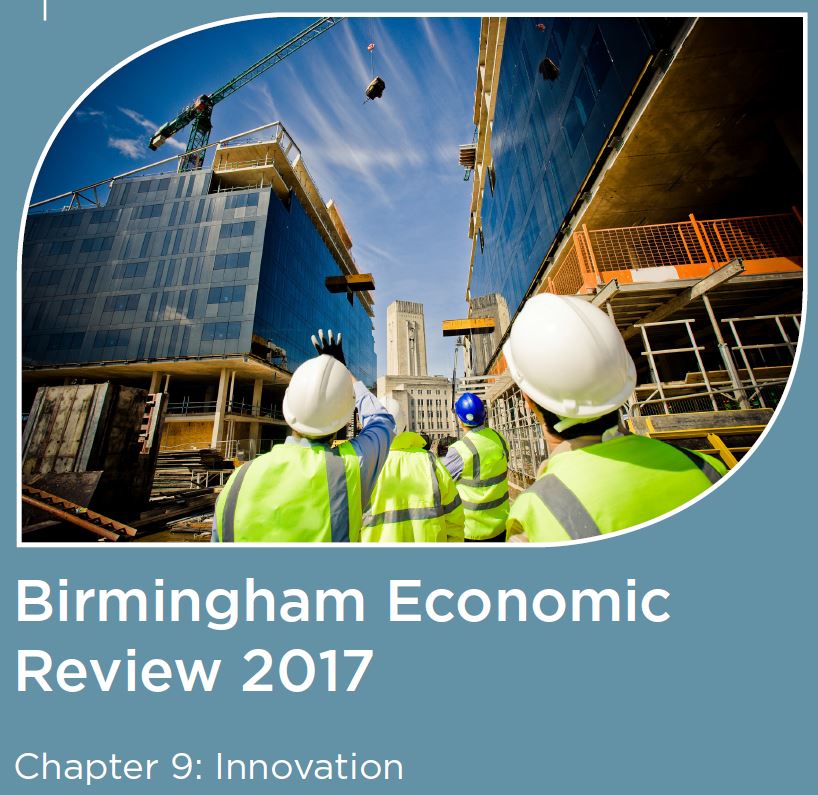The Birmingham Economic Review was produced in October 2017 by City-REDI, the Greater Birmingham Chambers of Commerce and the West Midlands Growth Company.
The review highlights the current strengths and weakness of the Birmingham economy, as well as looking at the opportunities and threats that might impact upon it in the future.
This is a commentary on Chapter 9 of the Review, Innovation:
Innovation is arguably the major driver of economic growth, within firms, across regions and the global economy as a whole. Firms succeed or fail on the basis of their ability to (1) continuously create new products and services that customers are willing to pay for, and (2) develop processes for delivering these products and services more cost-effectively. Both underpin improvements in productivity and gross value-added (GVA) levels. But firms do not innovate in isolation. They rely on regional, national and/or international networks of partner organisations, including suppliers, contractors, universities and consultancies that provide components, technology, skills, knowledge and expertise as an input into the innovation process.
Places compete to attract inward investment and skilled people, partly on the basis of the competitive advantages they can offer as distinctive regional innovation systems (RIS). This includes universities as part of the science and technology asset-base. The role of universities is emphasised in the Government’s Industrial Strategy and related reports, including the Science and Innovation Audit’s (SIAs). The regional SIA highlights Warwick University (including Warwick Manufacturing Group), Jaguar Land Rover, the University of Birmingham and the Manufacturing Technology Centre (MTC) as ‘nationally and internationally significant science and innovation assets’. Both universities were recently ranked in Europe’s 100 most innovative universities by Reuters and account for two-thirds of all Innovate UK funding into the area over the 2010-15 period.
Science and technology (S&T) sectors employ around 350,000 employees in the region covered by the SIA (20 percent of jobs) but these are growing more slowly (4 percent over 2009-2015) than the national average (9 percent growth). Many are employed in one of the R&D ‘hot spots’: advanced manufacturing technology (including materials, low carbon transport and data systems); digital technologies (computer programming, IT consulting, games software and data processing); next generation transport (automotive, rail, aerospace); energy storage and systems; construction and health and life sciences (overseen by Birmingham Health Partners).
The challenge for the region is to build on these existing areas of RIS strength by:
- attracting new investment from existing firms, such as JLR, encouraging them to focus global Research and Development (R&D) activities in specific technology areas in the city-region
- attracting new firms, particularly foreign direct investment, to locate R&D-intensive activities in the region, to complement the existing specialisations
- promote spin-offs from universities alongside start-ups and ‘scale-ups’ in the target areas of S&T to build agglomeration economies, or clusters, with economies of scale
Inward investment and a healthy local business birth rate are important attractions for skilled, creative people, who in turn drive innovation in and between firms. To do promote both effectively the Birmingham city region must clearly and precisely identify its competitive advantages as a distinctive location for particular areas of S&T and focus resources on these distinctive assets and capabilities. This also means linking the many components of innovation to better-understand and proactively develop the RIS as a complex ecosystem. Infrastructure, large and small firms, a wide variety of skills, including professional and creative talent, financing mechanisms, universities and related clusters of R&D all interact and need to be understood in relation to each other.
To download a copy of the Birmingham Economic Review, please click here.
This commentary was written by Professor Simon Collinson, Director, City-REDI.
Disclaimer:
The views expressed in this analysis post are those of the authors and not necessarily those of City-REDI or the University of Birmingham
To sign up to our blog mailing list, please click here.

